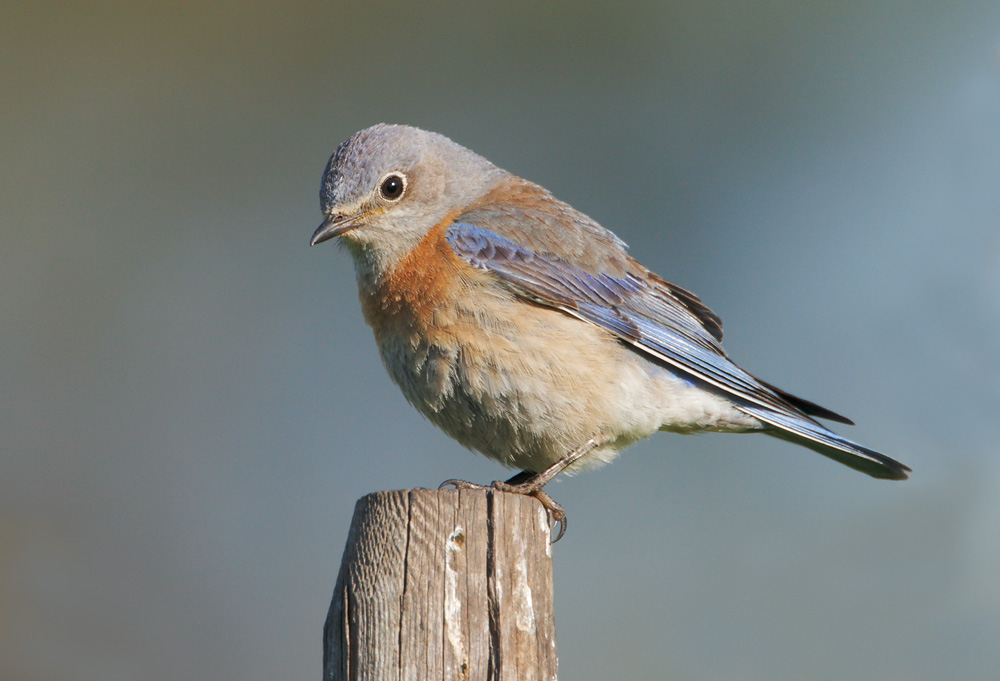Male Western Bluebird with its characteristic blue body and orange chest Photo credits: http://www.mangoverde.com/wbg/picpages/pic138-63-2.html
The Western Bluebird, one of three species of bluebirds in North America, is commonly located in the western part of Canada and southwestern part of the USA and is often seen within open coniferous or deciduous woodlands¹.
Geographic range of Western Bluebirds showing where they can be found during the different seasons. Photo credit: http://identify.whatbird.com/obj/150/overview/Western_Bluebird.aspx
Like all bluebirds, males sport the bright blue plumage with a bright orange breast, while females are considerably duller in colour – only having some blue within their wings and having a pale orange breast. Because of the plumage seen in males, they can be confused for the Eastern Bluebird (Sialia sialis) but key differences between the two species come down to the colour on the throat and the belly. The Western Bluebird maintains the blue colouring on their throat and belly while the Eastern Bluebird has an orange throat and lacks any colour on their belly¹. If plumage colour doesn’t help with the identification, know that where they can be found does not overlap with each other.

Female Western Bluebird distinguished by its duller colours in comparison to its male counterpart Photo credit: http://tgreybirds.com/Pages/WesternBluebirdp.html
Bluebirds are social creatures and the Western Bluebird is no exception. They can be seen forming flocks with each other and with other birds to feed¹. They will typically feed on insects, leaping down from their perch in order to catch them, as well as berries. Western Bluebirds are birds that nest within holes in trees or in nest boxes. They are not equipped to form their own holes which cause them to rely on woodpeckers to create appropriate nesting areas for them. Within these cavities, females with form their nests and lay their eggs. Western Bluebirds are generally monogamous, with each pair of bluebirds raising their young together. But they are also known to have helper birds that will help them raise their young¹.

Western Bluebird returning to its nestbox with food Photo credit: http://www.examiner.com/article/the-western-bluebird-san-diego
You would be hard pressed to see a Western Bluebird in open woodlands. While according to the IUCN Red List, Western Bluebirds are in no risk, sightings of these birds are hard to come by. The biggest reason is due to loss of habitat which leads to loss of appropriate nesting areas for these birds. Logging, competition for space, and limited nesting areas have all contributed to seeing fewer birds. Western Bluebirds are threatened by increased competition for nesting cavities from other cavity nesters, especially from invasive species, such as the European Starling and the House Sparrow².
There are several conservation efforts to re-establish breeding populations on Vancouver Island, with the most well known project from the Garry Oak Ecosystems Recovery Team (GOERT), Bring Back the Bluebirds, leading the way. By providing new nestboxes and with the use of translocations, the project hopes to release 90 adult bluebirds back into the Cowichan Valley³.
However, there are some ways YOU can help increase the chances the seeing Western Bluebirds, even possibly seeing one in your own backyard. You can help the bluebirds by putting up a nestbox, monitoring activity, and reporting bluebird sightings.
¹ Western Bluebird. Cornell Lab of Ornithology. [accessed 2015 Oct 20]. http://www.allaboutbirds.org/
² Western Bluebird. March 19, 2015. Nature Conservancy Canada. [accessed 2015 Oct 20]. http://www.natureconservancy.ca
³ Goert.ca,. ‘GOERT : Our Activities : Bring Back The Bluebirds Project’. N.p., 2015. Web. 2 Nov. 2015.

